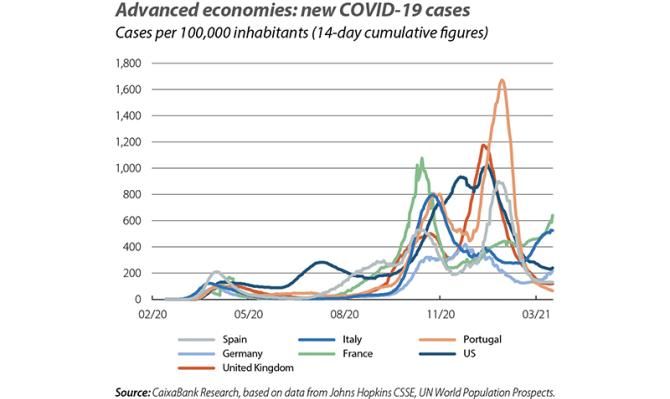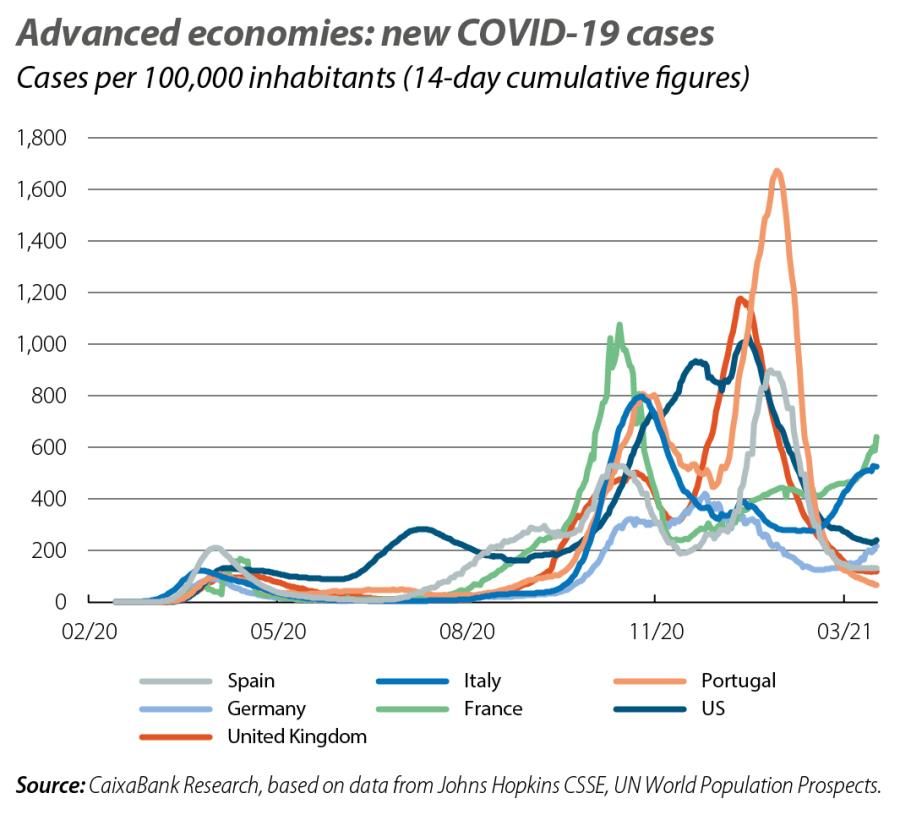A transatlantic gap opens up in the world economy

The pandemic continued to weigh down on the global economy during the first quarter of the year, during which restrictions were maintained to reduce the spread of COVID-19 in most major countries around the world. Despite the fact that economies are showing greater resilience to these restrictions (particularly in the manufacturing sector), the recovery in economic activity has been constrained, and some countries likely suffered a slight decline in GDP in Q1. This could be the case in the euro area, where restrictions remained in place throughout the first quarter of the year. Given the recent rise in the number of COVID-19 cases in Italy, France and Germany, restrictions are likely to continue to weigh down on economic activity at the beginning of Q2. In contrast, in the United Kingdom and the US the curve of new cases improved at the end of March and restrictions were eased in certain regions and states.

The rollout of the vaccines has been relatively slow in Europe so far. Supply and distribution problems have led to frustration between countries, and the EU even raised the possibility of banning vaccine exports to the United Kingdom. However, Europe’s vaccination process is expected to accelerate during Q2 as the vaccine supply and distribution issues are resolved. France, for instance, recently announced that at least 35 «vaccinodromes» – mass vaccination centres with the capacity to administer 1,000-2,000 vaccines a day – will be opened across the country in the coming days. In contrast, in the United Kingdom and the US the vaccination process is already much further ahead, which will no doubt enable their economies to reopen and recover sooner. In the US, for instance, President Joe Biden has doubled his initial promise to vaccinate 100 million people in the first 100 days of his presidency, and more recently has promised access to the vaccine for all adults from 1 May.

AVANCED ECONOMIES
According to the latest estimate by Eurostat, the fall in GDP in Q4 2020 (–0.7% quarter-on-quarter) was mostly due to weak household consumption, which fell by 3% quarter-on-quarter, while the rest of the components of demand registered moderate growth. Behind this weakness in consumption lies a build-up of pent-up demand as a result of the COVID-19 crisis (we estimate that it exceeds 3% of GDP). Over the coming quarters, this could help to spur the recovery once improvements in the pandemic allow the restrictions to be eased and uncertainty over the future evolution of the economy clears. For the time being, the indicators suggest a contained performance from euro area economic activity at the beginning of the year, and although it improved in March (52.5 points, up from the 48.8 in February), the composite Purchasing Managers’ Index (PMI) remains close to the 50-point threshold which separates recession from expansion, weighed down by the services component.


The US shows far more buoyancy than the euro area, as is clearly reflected in its composite business sentiment index, which stood at 59.1 points in March. Not only is this level
well above the European index but it also indicates a marked increase in economic activity during Q1 (despite the winter storm that affected the south of the country in February). One of the explanations for this greater buoyancy, besides the US economy’s greater resilience to the pandemic, is the scale and ambition of the fiscal policy measures introduced by the Biden administration. Last month’s Monthly Report documented the approval of the new COVID-19 aid package (worth 1.9 trillion dollars, with 1,400-dollar cheques going out to most Americans), which came in addition to the 0.9 trillion approved in December. Meanwhile, the Democratic Party has announced its intention to legislate another fiscal package, this time focusing on medium-term investments in infrastructure and education, which could amount to around 2 trillion dollars. All in all, the US economy is expected to recover to its pre-crisis level in 2021, well before the euro area, illustrating the ambition of the US rescue measures, the resilience of its economy and the faster rate of vaccination compared to the EU. In this regard, the NGEU European recovery plan, through which the EU will provide some 750 billion euros in grants and loans to Member States, remains crucial in preventing the widening of the transatlantic economic gap that is beginning to open up. NGEU is expected to be activated in the coming months. However, the risk of further delays from European institutions was highlighted at the end of March when the German Constitutional Court temporarily suspended ratification of the European recovery fund, raising the possibility that the fund’s first transfers expected during the summer could be delayed.

This is reflected in the rise in US sovereign yields, fuelled by investors who expect the country’s economy to normalise more quickly. The debate on the future path of US inflation also continues, with price growth standing at 1.7% in February (3 decimal points above the figure for January), largely driven by the sharp rise in petrol prices. Core inflation, meanwhile, stood at 1.3%. For the coming months, inflation is expected to continue to rise as a result of pandemic-related base effects (headline inflation could temporarily reach around 3%). In this context, all the indicators suggest that the potential risks of higher inflation and overheating in the country will remain present (see the Focus «New fiscal package in the US: overheating in sight?» in this same Monthly Report).

The latest forecasts presented by the US central bank in March suggest that the increase in inflation will be temporary, peaking in 2021 before gradually falling back down to around the 2% target over the coming years. The Fed also significantly increased its economic growth forecasts to incorporate the impact of the new fiscal package, and it now expects year-on-year GDP growth in Q4 2021 to reach 6.5% (previously 4.2%), with the unemployment rate falling below 4% in 2022 (in the previous forecasts, this threshold was not expected to be crossed until 2023). Although this improvement in the economic outlook has begun to generate expectations of a reduction in the stimuli in the financial markets, the Fed kept its monetary policy stance unchanged. It also reaffirmed that its current priority is to achieve the goal of maximum employment (recalling that there is still a lot of ground to recover in this regard) and reiterated that, as long as the data do not show otherwise, the risk of persistent inflation will remain a secondary consideration.

EMERGING ECONOMIES
As explained in the Financial Markets section, most emerging currencies have weakened in the face of rising US sovereign interest rates and the strength of the dollar. Nevertheless, the reaction so far has been much more contained than during the taper tantrum of 2013, when expectations of a normalisation in US monetary policy led to significant stress in the most vulnerable countries’ currencies. In Turkey, in contrast, the lira plummeted following the removal of the governor of the central bank, which occurred within days of a 200-bp interest rate hike that brought them up to 19%. This action by President Erdogan highlights the risk of continued political interventionism in the country, and the external financial conditions are likely to remain stressed. In any case, so far this episode does not appear to have had too much impact on the currencies of other emerging countries, whose recent depreciation against the dollar has been contained and largely driven by the strength of the US.

In March, the number of COVID-19 cases fell in Mexico and Russia, but rose in India and Brazil, where the situation is more alarming. In Brazil, the number of cases reached 485 per 100,000 inhabitants (14-day cumulative figure), a situation complicated by the increase in political polarisation in the country. China, meanwhile, awoke following the Lunar New Year’s party with a temporary rebound in economic activity. In the combined period for January and February, its industrial production grew by 35.1% year-on-year and its retail sales, by 33.8%. Although this rebound should not surprise us, since in the first two months of 2020 China had shut down much of the country in order to contain the virus, both figures exceeded expectations.
